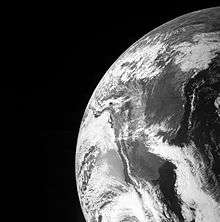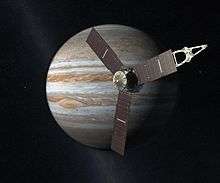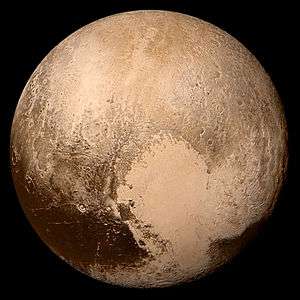New Frontiers program

The New Frontiers program is a series of space exploration missions being conducted by NASA with the purpose of researching several of the Solar System bodies, including the dwarf planet Pluto.
NASA is encouraging both domestic and international scientists to submit mission proposals for the project.[2] New Frontiers was built on the innovative approach used by the Discovery and Explorer Programs of principal investigator-led missions. It is designed for medium-class missions that cannot be accomplished within the cost and time constraints of Discovery, but are not as large as Flagship-class missions. There are currently three New Frontiers missions in progress: New Horizons, which was launched in 2006 and reached Pluto in 2015, Juno, which was launched in 2011 and entered Jupiter orbit in 2016, and OSIRIS-REx, launched in September 2016 towards asteroid Bennu for detailed studies from 2018 to 2021 and a sample return to Earth in 2023.
History

The New Frontiers program was developed and advocated by NASA and granted by Congress in CY 2002 and 2003. This effort was led by two long-time NASA executives at Headquarters at that time: Edward Weiler, Associate Administrator of Science and Colleen Hartman, Solar System Exploration Division Director. The mission to Pluto had already been selected before this program was successfully endorsed and funded, so the mission to Pluto, called New Horizons, was "grandfathered" into the New Frontiers program. The 2003 Planetary Science Decadal Survey from the National Academy of Sciences identified destinations that then served as the source of the first competition for the New Frontiers program. The program name was selected by Hartman based on President John F. Kennedy's speech in 1960, in which he said "We stand, today, on the edge of a New Frontier."
Examples of proposed mission concepts include two tranches of several mission concepts based on decadal survey goals.[3]
- From New Frontiers in the Solar System: An Integrated Exploration Strategy
- Kuiper Belt Pluto Explorer (realized in New Horizons)
- Jupiter Polar Orbiter with Probes (led to Juno)
- Venus In Situ Explorer
- Lunar South Pole-Aitken Basin Sample Return Mission
- Comet Surface Sample Return Mission (see also the similar OSIRIS-REx, which is planned for NEO not a comet and also the ESA's Rosetta spacecraft, which orbits and dropped a lander on a comet in 2014–2015)
- From Vision and Voyages for Planetary Science in the Decade 2013–2022
- Io Volcano Observer
- Lunar Geophysical Network
- Saturn Probe
- Trojan Tour and Rendezvous
Missions in progress
New Horizons (New Frontiers 1)
New Horizons, a mission to Pluto, was launched on January 19, 2006. After a Jupiter gravity assist in February 2007 the spacecraft continued towards Pluto. The primary mission flyby occurred in July 2015 and the spacecraft was then targeted toward one Kuiper Belt object called '2014 MU69' for a January 1, 2019 flyby. Another mission that was considered with this mission was New Horizons 2.
Juno (New Frontiers 2)

Juno is a Jupiter exploration mission which launched on August 5, 2011 and arrived in July 2016. It is the first solar-powered spacecraft to explore an outer planet. The craft was placed into a polar orbit in order to study the planet's magnetic field and internal structure. NASA's Galileo mission to Jupiter provided extensive knowledge about its upper atmosphere, however, further study of Jupiter is crucial not only to the understanding of its origin and nature of the Solar System, but also of giant extrasolar planets in general. The Juno spacecraft investigation is intended to address the following objectives for Jupiter:
- Understand Jupiter's gross dynamical and structural properties through determination of the mass and size of Jupiter's core, its gravitational and magnetic fields, and internal convection;
- Measure the Jovian atmospheric composition, particularly the condensable-gas abundances (H2O, NH3, CH4 and H2S), the Jovian atmospheric temperature profile, wind velocity profile, and cloud opacity to greater depths than achieved by the Galileo entry probe with a goal of 100 bar at multiple latitudes; and
- Investigate and characterize the three-dimensional structure of Jupiter's polar magnetosphere.
OSIRIS-REx (New Frontiers 3)
.png)
OSIRIS-REx stands for "Origins, Spectral Interpretation, Resource Identification, Security, Regolith Explorer".[4] This mission plan is to orbit an asteroid, at the time named 1999 RQ36 (now 101955 Bennu), by 2020. After extensive measurements, the spacecraft will collect a sample from the asteroid's surface for return to Earth in 2023. The mission, excluding the launch vehicle, is expected to cost approximately $800 million. The returned sample will help scientists answer long-held questions about the formation of the Solar System and the origin of complex organic molecules necessary for the origin of life.
Asteroid Bennu is a potential future Earth impactor and is listed on the Sentry Risk Table with the third highest rating on the Palermo Technical Impact Hazard Scale (circa 2015).[5] In the late 2100s there is a cumulative chance of about 0.07% it could strike Earth, therefore there is a need to measure the composition and Yarkovsky effect of the asteroid.[6]
Future New Frontiers missions

Competition for the fourth mission will begin in 2017, and NASA will select several proposals for additional concept studies by November 2017, select a winner in the competition in 2019, then launch it in 2024.[2][7][8] Investigators may propose the use of Multi-Mission Radioisotope Thermoelectric Generators (MMRTG), and the NASA Evolutionary Xenon Thruster (NEXT) ion propulsion system.[8] Based on their science value and projected costs, the 2013-2022 Planetary Science Decadal Survey committee identified seven desired themes:[9]
- Comet Surface Sample Return - A comet nucleus lander and sample return mission
- Io Observer - A Jupiter orbiter investigating the internal structure and mechanisms of Io
- Lunar Geophysical Network - Several identical landers conducting geophysical studies of the Moon
- Lunar South Pole-Aitken Basin Sample Return - A mission to land at the Moon's South Pole–Aitken basin and return samples to Earth
- Saturn Probe - A mission that would send a probe into Saturn's atmosphere
- Trojan Tour and Rendezvous - A mission to fly by two or more Trojan asteroids including an extended rendezvous with a Trojan
- Venus In Situ Explorer - A Venus atmospheric probe and lander
For New Frontiers 4, the Decadal Survey recommended that the mission select from Comet Surface Sample Return, Lunar South Pole-Aitken Basin Sample Return, Saturn Probe, Trojan Tour and Rendezvous, and Venus In Situ Explorer. The Decadal Survey additionally recommended the Io Observer and Lunar Geophysical Network proposals for New Frontiers 5 in additional to the previous recommendations.[9] NASA's Planetary Science Division responded to the Decadal Survey with support, stating that the recommendations appear well-aligned with the agency's goals.[10]
References
- ↑ "New Frontiers Program Official Website (June 2016)". National Aeronautics and Space Administration (NASA). January 15, 2016. Archived from the original on June 10, 2016. Retrieved January 15, 2016.
- 1 2 Foust, Jeff (January 8, 2016). "NASA Expands Frontiers of Next New Frontiers Competition". Space News. Retrieved January 20, 2016.
- ↑ nasa nf
- ↑ NASA. "NASA to Launch New Science Mission to Asteroid in 2016". Retrieved May 25, 2011.
- ↑ "Sentry Risk Table". NASA/JPL Near-Earth Object Program Office. July 21, 2015. Archived from the original on July 21, 2015. Retrieved July 21, 2015.
- ↑ Milani, Andrea; Chesley, Steven R.; Sansaturio, Maria Eugenia; Bernardi, Fabrizio; et al. (2009). "Long term impact risk for (101955) 1999 RQ36". Icarus. 203 (2): 460–471. arXiv:0901.3631
 . Bibcode:2009Icar..203..460M. doi:10.1016/j.icarus.2009.05.029.
. Bibcode:2009Icar..203..460M. doi:10.1016/j.icarus.2009.05.029. - ↑ Clark, Stephen (September 7, 2016). "NASA official says new mission selections on track despite InSight woes". Spaceflight Now. Retrieved September 8, 2016.
- 1 2 New Frontiers fourth announcement of opportunity. NASA, January 6, 2016.
- 1 2 Vision and Voyages for Planetary Science in the Decade 2013-2022 (PDF). The National Academies Press. 2011. pp. 15–16. ISBN 978-0-309-22464-2.
- ↑ Weiler, Edward J. (29 July 2011). "Planetary Science Division Response to the Planetary Science Decadal Survey" (PDF) (Letter). Letter to Charles F. Kennel.

.jpg)

